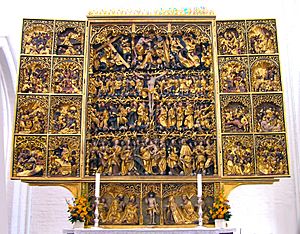Passion cantata facts for kids
A Passion cantata is a special type of cantata. A cantata is like a story told with music, often for singers and instruments. Passion cantatas tell the story of Jesus Christ's suffering and death. This story is called the "Passion."
Bigger musical pieces about the Passion are known as oratorios. Today, many Passion cantatas are performed in the week before Easter.
Contents
The History of Passion Music
For a very long time, people have read the story of the Passion from the Gospels during Holy Week. This tradition goes back at least to the 300s AD. In the 400s, Pope Leo the Great decided which Gospel readings to use on different days.
Over time, people started to sing the Passion story instead of just speaking it. This began as early as the 700s. By the 1200s, different singers would take on the roles of different characters in the story. For example, one singer would be the narrator, another would be Jesus, and others would sing the parts of the crowd.
By the 1400s, new ways of setting the Passion to music appeared:
- Responsorial Passions: In these, the narrator's part was chanted (sung simply), but the parts for the crowd (called turba) and sometimes Jesus were sung with many voices at once. This style is called polyphonic.
- Through-composed Passions: These were also called motet Passions. In this style, all the words were set to music with many voices singing together. One of the earliest examples might have been by Jacob Obrecht.
- Summa Passionis settings: These pieces combined parts of the Passion story from all four Gospels. They weren't usually used in church services but were still very popular. The famous "Seven Last Words" – the last things Jesus said – are an example of this type. Later, composers like Haydn and Théodore Dubois set these words to music.
Famous Passion Cantatas
Many composers have written beautiful Passion cantatas. Here are some well-known examples from different languages:
English Passion Cantatas
In the English-speaking world, two very famous Passion cantatas are The Crucifixion (from 1887) by Sir John Stainer and Olivet to Calvary (from 1904) by John Henry Maunder. Other important works include The Passion of Christ (1914) by Sir Arthur Somervell, St. Mark Passion (1921) by Charles Wood, and "The Last Supper" (1930) by Eric Thiman.
German Passion Cantatas
The most famous Passion cantatas of all are probably the two written by Johann Sebastian Bach. These are the St John Passion (from 1724) and the St Matthew Passion (from 1727). For a while, people thought he also wrote the St Luke Passion (1730). But now, experts believe he simply changed an older piece of music.
Latin Passion Cantatas
One important Passion cantata in Latin is Passio Domini Nostri Jesu Christi secundum Joannem (which means The Passion of Our Lord Jesus Christ according to John). This piece was written in 1982 by Arvo Pärt.
Images for kids
-
Testimony of the false witnesses from Guerrero's responsorial Matthew's Passion (1585).
See also
 In Spanish: Pasión (música) para niños
In Spanish: Pasión (música) para niños



